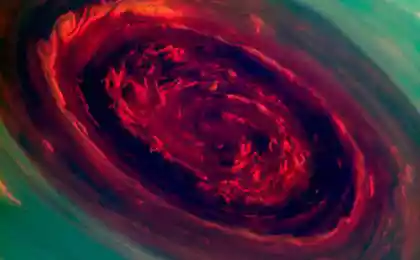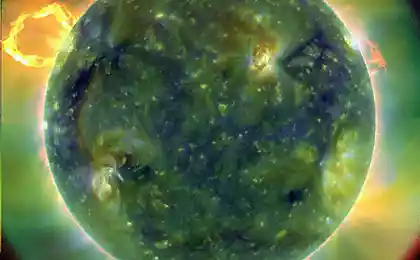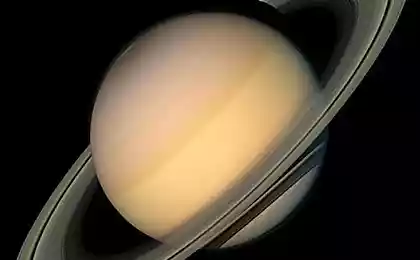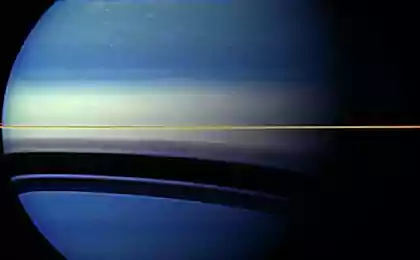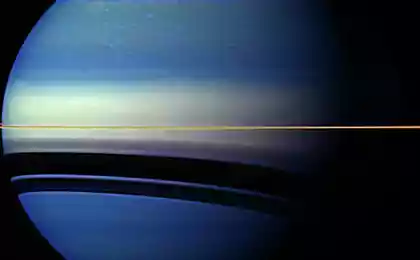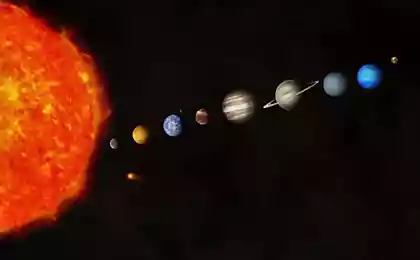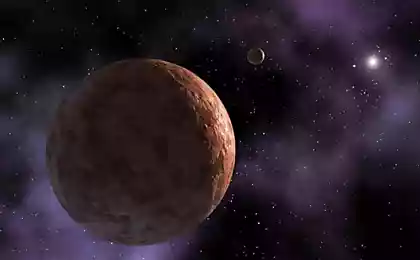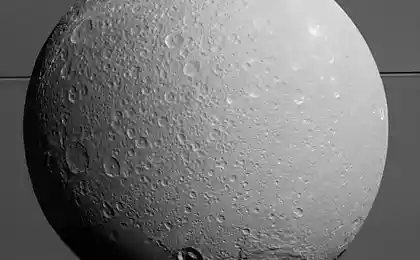986
Journey through the rings of Saturn (12 photos)
Starting from the XVII century people are trying to restore the information about the rings of Saturn, the strange formations around the second largest planet in the Solar System. The width of the ring is huge: they are five times greater than the diameter of the Earth!
Since the beginning of the space era Saturn visited five spacecraft. The last of them, "Cassini", still works. Through his pictures in front of us opened gradually absolutely unique, fantastic beauty of the picture that are not found anywhere else in the solar system.
Galileo, the first person who saw Saturn through a telescope, was struck by his appearance. No, he did not see the ring - the first telescope gave only 30-fold increase, and optics was, to put it mildly, not very good. But Galileo noticed around the planet "ears", which gave the Saturn elongated shape, and he could not understand what they represent.

In the end, he decided that it was the satellites of the planet. Only a few decades, astronomers have established the nature of these "ears" and were amazed. This image - one of the first color received by the station, NASA "Cassini" after arriving in the Saturnian system in 2004. Gorgeous ring for 7 years will be one of the most interesting research subjects in this distant, unlike the others, the system
Waves within the Encke gap. The fact that not one of Saturn's ring, it became clear already in the XVII century, when Italian astronomer Cassini discovered a gap, named after him. Later, with the improvement of telescopes, astronomers have found more and more gaps in the ring giant planet. It turned out that instead of a solid ring of Saturn surround the great variety of rings and rings. Encke gap open in the XIX century, too, was not empty. The photo shows clearly two ringlet within the Encke gap. Also in 1990, was discovered Saturn's moon Pan orbit which takes place entirely inside the gap. This satellite shepherd and cleared space in the rings, and its gravitational influence produces choppy waves and irregularities within the Encke gap. The picture received 7 October 2006 NASA spacecraft "Cassini»
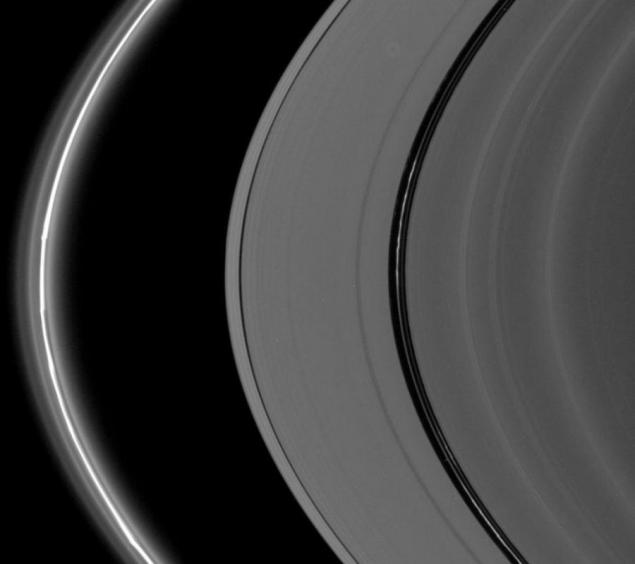
Looking at the Saturn ring at a small angle, it is possible to distinguish a plurality of gaps, slits, and the slits between the rings. The rings differ from each other in width, and brightness. Note the star on the far "tip." This 32-kilometer-long companion Atlas; its orbit passes between rings A and F.
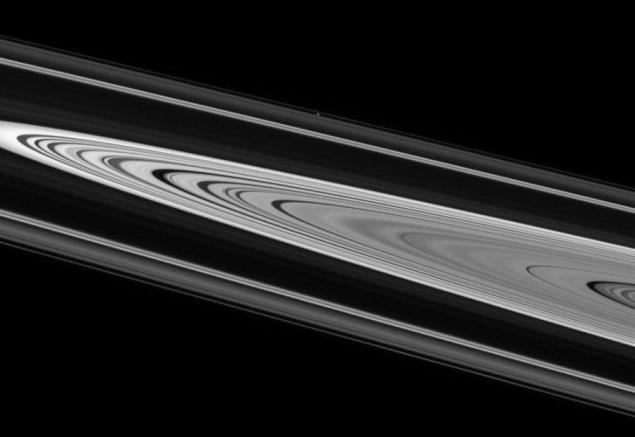
Saturn's system is similar to the solar system in miniature. Satellites circling the giant planet like planets around the sun. But there is one major difference: the Sun has no such luxury rings. Saturn's rings are very thin. Their thickness is usually only a few meters, and in any case never happens more than 10 kilometers. However, the rings can cast a shadow. This photograph shows that the shadow rings of black in some places, and in the other gray. This means that they reflect light differently.
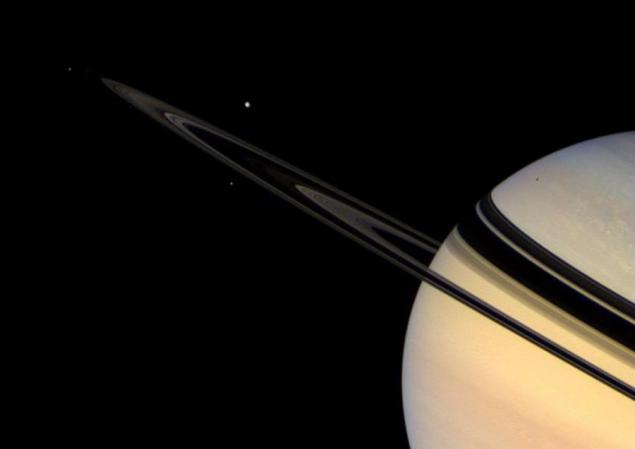
It is best waves in Saturn's rings seen in the ring F. The force of attraction of Prometheus, 86-kilometer-long companion, which is visible in the photo, distorts the structure of the ring, creating a diagonal education. The picture received August 30, 2008 at a distance of 1, 2 million km.

The orbit of the spacecraft "Cassini" was chosen so that the March 3, 2005 in a land overshadowed ring. Then the "Cassini" sent to our planet three radio wavelengths 0, 94, 3, 6 and 13 inches. The signals passing through the rings of Saturn, is somewhat distorted. According to these changes, scientists have an idea as to the thickness of the rings, and the material from which they are composed. This image is constructed from the Cassini Division and radio measurements of the ring A. It was found that the thickness of A is equal to about 10 km, and in the outer ring and the Encke gap around the observed density waves generated by the satellite-herders. Artificial colors provide information about the size of the particles that make up the ring. The purple color indicates the particles less than 5 cm in diameter. Green and blue colors indicate particles of 1-5 cm and less than 1 cm in diameter
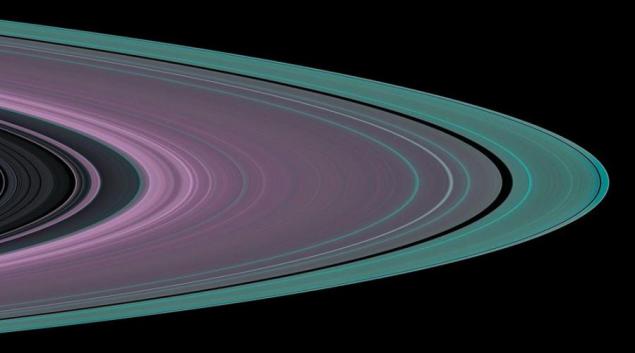
Colored threads and shadows. Amazing picture appeared before the cameras, "Cassini" July 30, 2004, shortly after arriving in the Saturnian system. The atmosphere of the gas giant was painted in smooth serene colors and thin translucent rings crossed his own shadow. The picture shows the ring C, near to Saturn, the Cassini division and wide, which can be seen even in the amateur telescope.
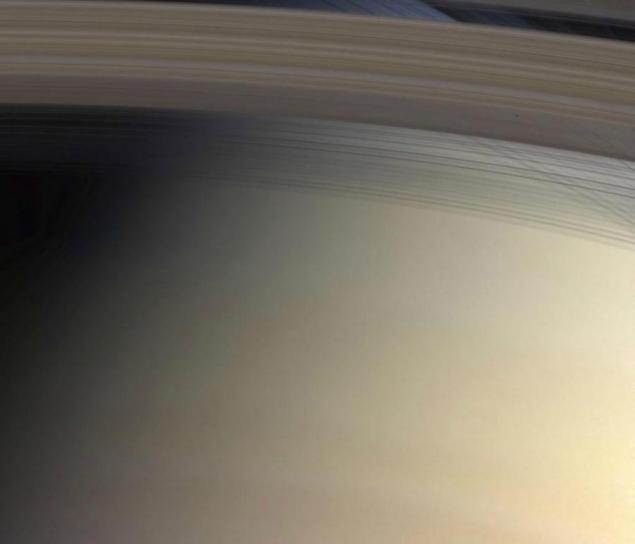
Fine shades of gold show us the inner ring B. The picture shows the Cassini division, filled with dull and very narrow rings. The edges of the Cassini Division are blurred when we look at it from a relatively short distance.
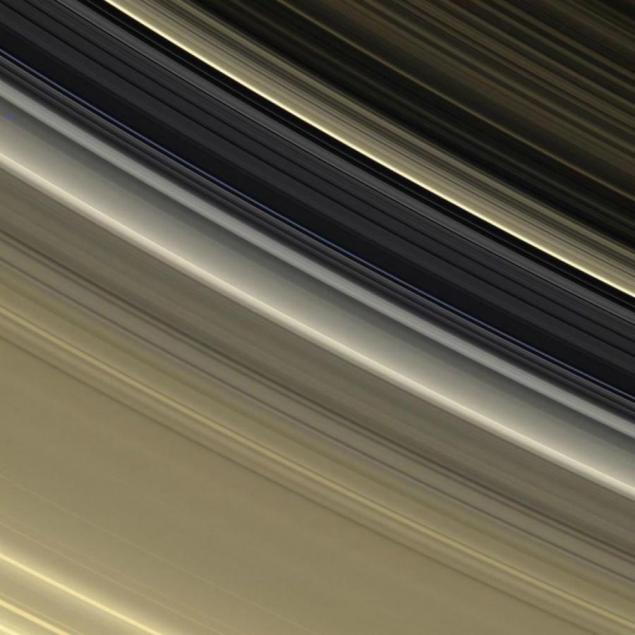
Not only rings can cast shadows on Saturn, and Saturn on the rings. See how sharp and clear the planet's shadow in a vacuum!
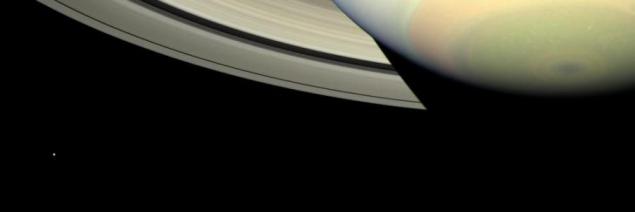
"Open the abyss full of stars ..." - wrote the great Lomonosov about the night sky. Replace the "star" to "moon" and you get the picture, imprinted probe "Cassini" in the Saturn system. As many as five satellites Janus, Mimas, Pandora, Prometheus and Atlas (left to right) we see on this magnificent picture. And if allowed permission, you would have noticed a few more. Unfortunately, many of Saturn's moons are too small for large-scale canvases. It's just the wrong shape pieces of rocks 5-15 km across. This picture was taken December 13, 2008 in the near-infrared light.
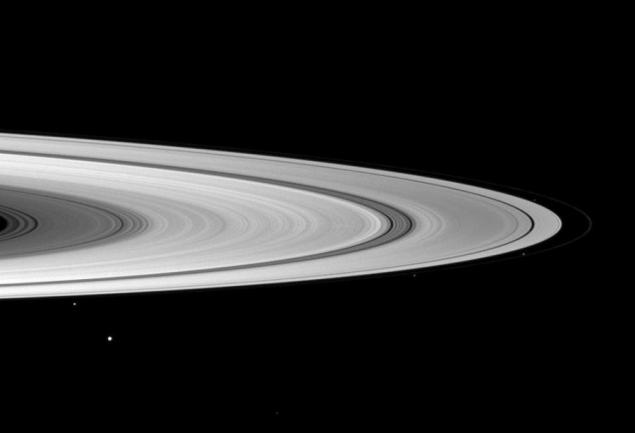
Strange "spokes" in Saturn's rings. In Saturn's rings are observed unusual education - "spokes", which are light and dark stripes running across the rings. For the first time the spokes were discovered "Voyager". The strange thing is that these bands behave like a single body, while Saturn's rings are not one body. The inner layers of rings revolve around the planet faster than external. By all the laws of celestial mechanics "spokes" must quickly break down, but it does not. What is the reason for their longevity, astronomers have yet to figure out.

The biggest vinyl in the world. Rings of Saturn in all its glory open the camera "Cassini" February 7, 2008. The result is a complex mosaic, tangled set of arcs, which lost a huge Cassini gap that separates the main rings A and B. But the narrow, sharp-edged slit Enke left visible fine. As located farther extremely narrow ring F. This branching formation with waves and loops entirely owes its existence to shepherd satellites, Pandora and Prometheus.

Source
Since the beginning of the space era Saturn visited five spacecraft. The last of them, "Cassini", still works. Through his pictures in front of us opened gradually absolutely unique, fantastic beauty of the picture that are not found anywhere else in the solar system.
Galileo, the first person who saw Saturn through a telescope, was struck by his appearance. No, he did not see the ring - the first telescope gave only 30-fold increase, and optics was, to put it mildly, not very good. But Galileo noticed around the planet "ears", which gave the Saturn elongated shape, and he could not understand what they represent.

In the end, he decided that it was the satellites of the planet. Only a few decades, astronomers have established the nature of these "ears" and were amazed. This image - one of the first color received by the station, NASA "Cassini" after arriving in the Saturnian system in 2004. Gorgeous ring for 7 years will be one of the most interesting research subjects in this distant, unlike the others, the system
Waves within the Encke gap. The fact that not one of Saturn's ring, it became clear already in the XVII century, when Italian astronomer Cassini discovered a gap, named after him. Later, with the improvement of telescopes, astronomers have found more and more gaps in the ring giant planet. It turned out that instead of a solid ring of Saturn surround the great variety of rings and rings. Encke gap open in the XIX century, too, was not empty. The photo shows clearly two ringlet within the Encke gap. Also in 1990, was discovered Saturn's moon Pan orbit which takes place entirely inside the gap. This satellite shepherd and cleared space in the rings, and its gravitational influence produces choppy waves and irregularities within the Encke gap. The picture received 7 October 2006 NASA spacecraft "Cassini»

Looking at the Saturn ring at a small angle, it is possible to distinguish a plurality of gaps, slits, and the slits between the rings. The rings differ from each other in width, and brightness. Note the star on the far "tip." This 32-kilometer-long companion Atlas; its orbit passes between rings A and F.

Saturn's system is similar to the solar system in miniature. Satellites circling the giant planet like planets around the sun. But there is one major difference: the Sun has no such luxury rings. Saturn's rings are very thin. Their thickness is usually only a few meters, and in any case never happens more than 10 kilometers. However, the rings can cast a shadow. This photograph shows that the shadow rings of black in some places, and in the other gray. This means that they reflect light differently.

It is best waves in Saturn's rings seen in the ring F. The force of attraction of Prometheus, 86-kilometer-long companion, which is visible in the photo, distorts the structure of the ring, creating a diagonal education. The picture received August 30, 2008 at a distance of 1, 2 million km.

The orbit of the spacecraft "Cassini" was chosen so that the March 3, 2005 in a land overshadowed ring. Then the "Cassini" sent to our planet three radio wavelengths 0, 94, 3, 6 and 13 inches. The signals passing through the rings of Saturn, is somewhat distorted. According to these changes, scientists have an idea as to the thickness of the rings, and the material from which they are composed. This image is constructed from the Cassini Division and radio measurements of the ring A. It was found that the thickness of A is equal to about 10 km, and in the outer ring and the Encke gap around the observed density waves generated by the satellite-herders. Artificial colors provide information about the size of the particles that make up the ring. The purple color indicates the particles less than 5 cm in diameter. Green and blue colors indicate particles of 1-5 cm and less than 1 cm in diameter

Colored threads and shadows. Amazing picture appeared before the cameras, "Cassini" July 30, 2004, shortly after arriving in the Saturnian system. The atmosphere of the gas giant was painted in smooth serene colors and thin translucent rings crossed his own shadow. The picture shows the ring C, near to Saturn, the Cassini division and wide, which can be seen even in the amateur telescope.

Fine shades of gold show us the inner ring B. The picture shows the Cassini division, filled with dull and very narrow rings. The edges of the Cassini Division are blurred when we look at it from a relatively short distance.

Not only rings can cast shadows on Saturn, and Saturn on the rings. See how sharp and clear the planet's shadow in a vacuum!

"Open the abyss full of stars ..." - wrote the great Lomonosov about the night sky. Replace the "star" to "moon" and you get the picture, imprinted probe "Cassini" in the Saturn system. As many as five satellites Janus, Mimas, Pandora, Prometheus and Atlas (left to right) we see on this magnificent picture. And if allowed permission, you would have noticed a few more. Unfortunately, many of Saturn's moons are too small for large-scale canvases. It's just the wrong shape pieces of rocks 5-15 km across. This picture was taken December 13, 2008 in the near-infrared light.

Strange "spokes" in Saturn's rings. In Saturn's rings are observed unusual education - "spokes", which are light and dark stripes running across the rings. For the first time the spokes were discovered "Voyager". The strange thing is that these bands behave like a single body, while Saturn's rings are not one body. The inner layers of rings revolve around the planet faster than external. By all the laws of celestial mechanics "spokes" must quickly break down, but it does not. What is the reason for their longevity, astronomers have yet to figure out.

The biggest vinyl in the world. Rings of Saturn in all its glory open the camera "Cassini" February 7, 2008. The result is a complex mosaic, tangled set of arcs, which lost a huge Cassini gap that separates the main rings A and B. But the narrow, sharp-edged slit Enke left visible fine. As located farther extremely narrow ring F. This branching formation with waves and loops entirely owes its existence to shepherd satellites, Pandora and Prometheus.

Source

